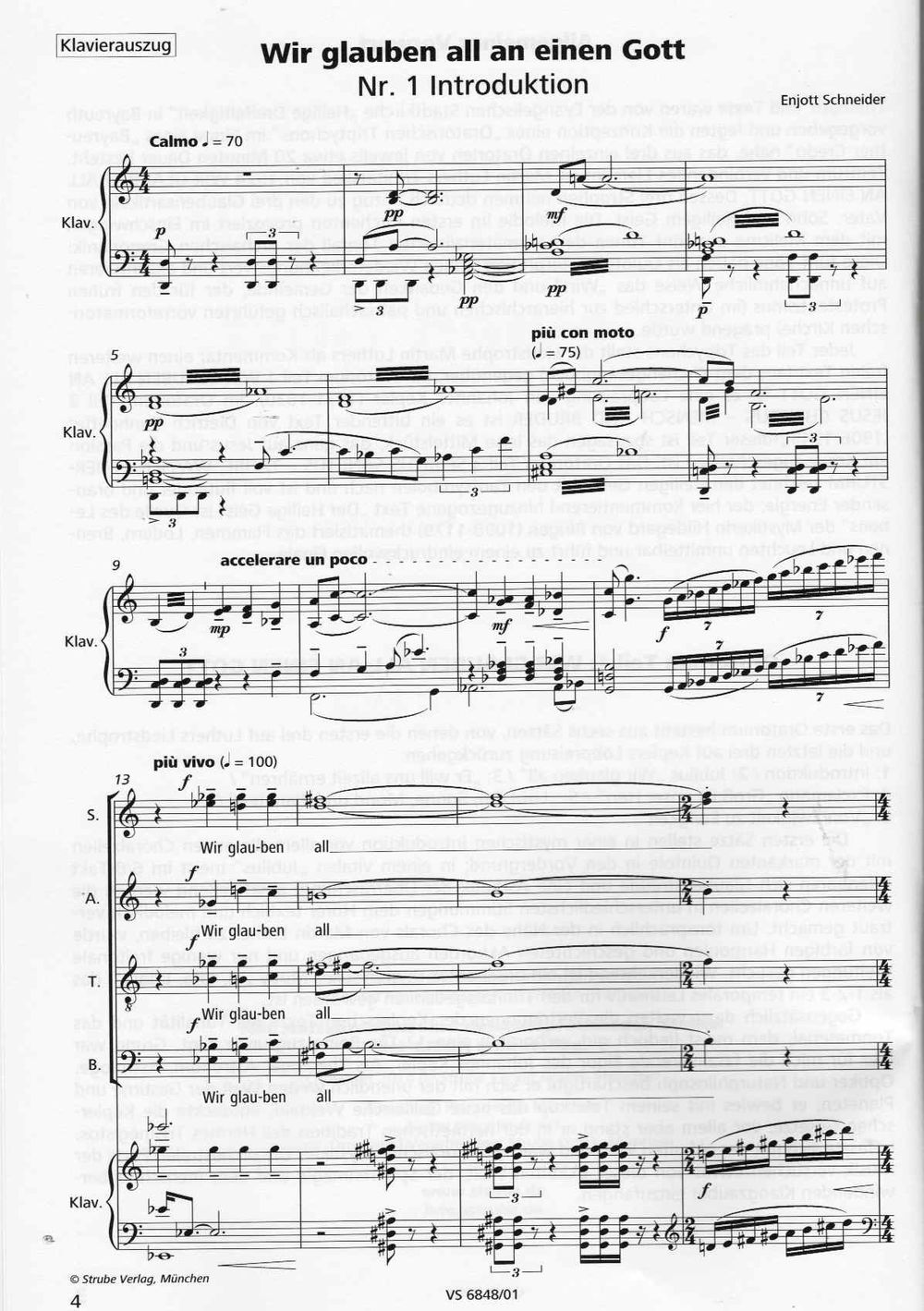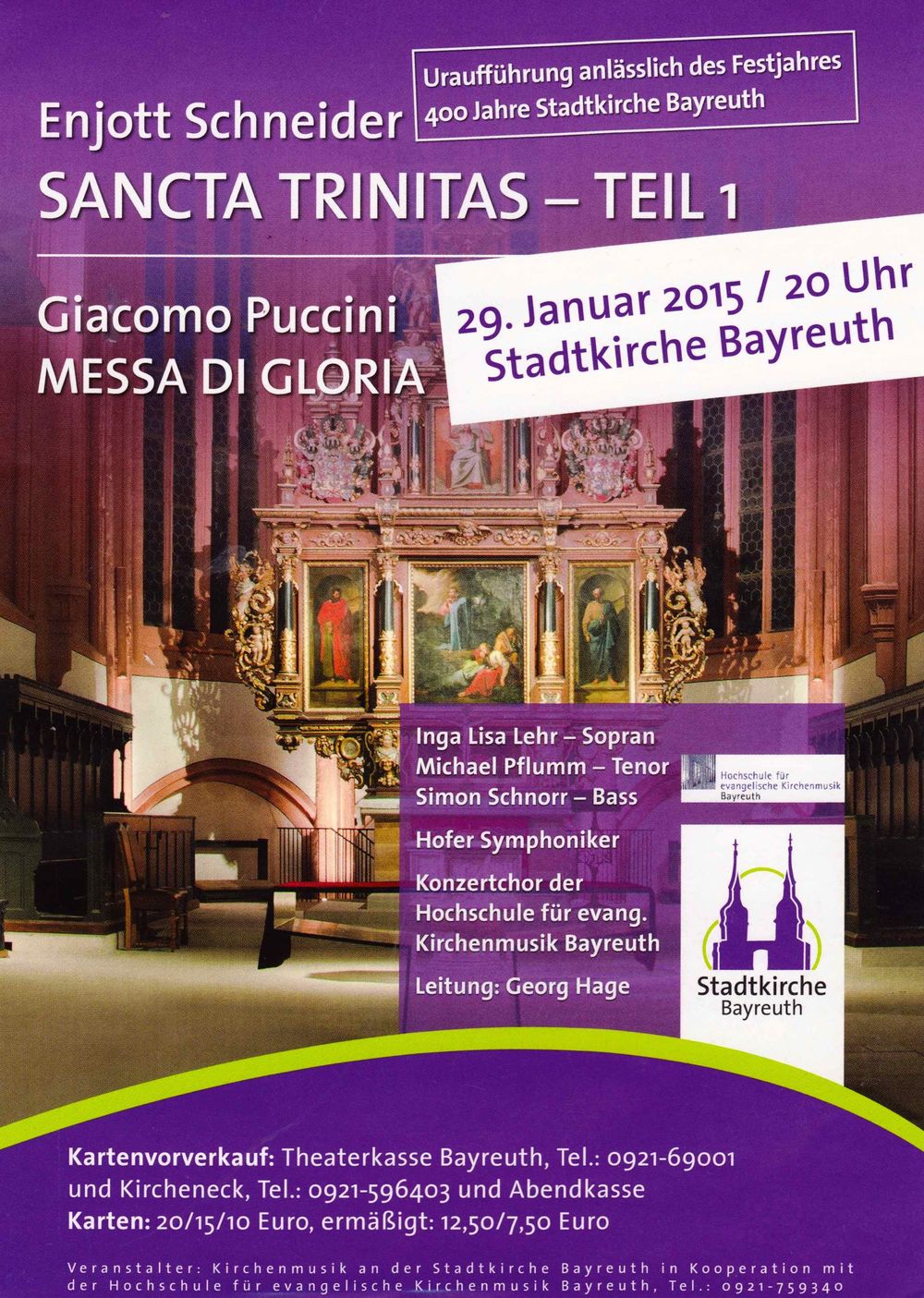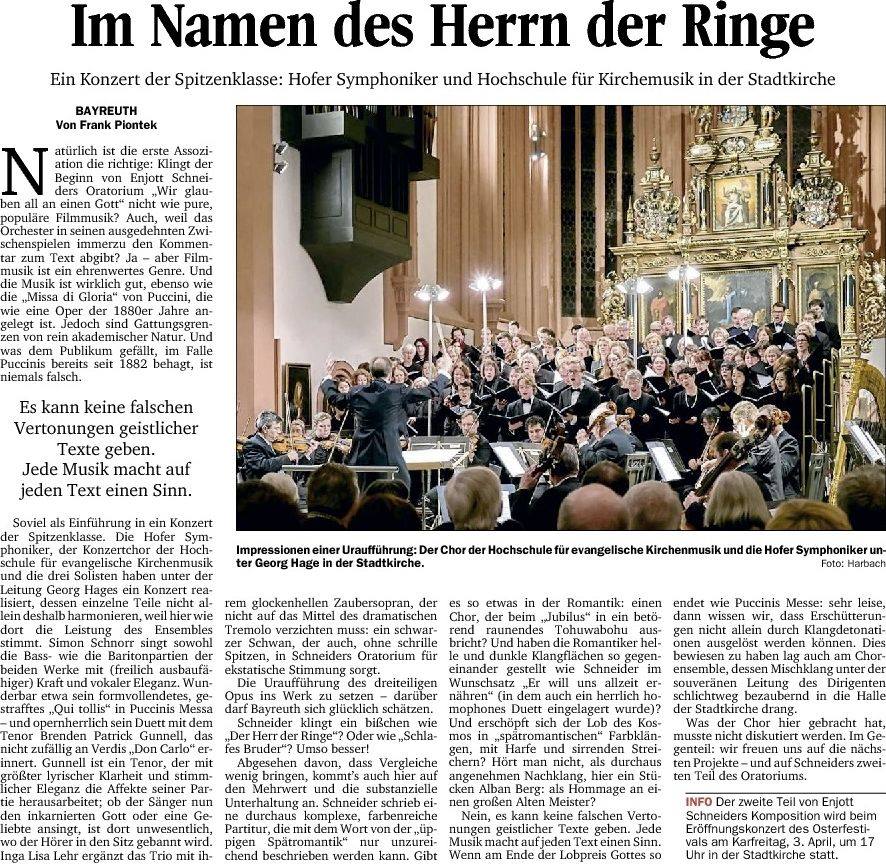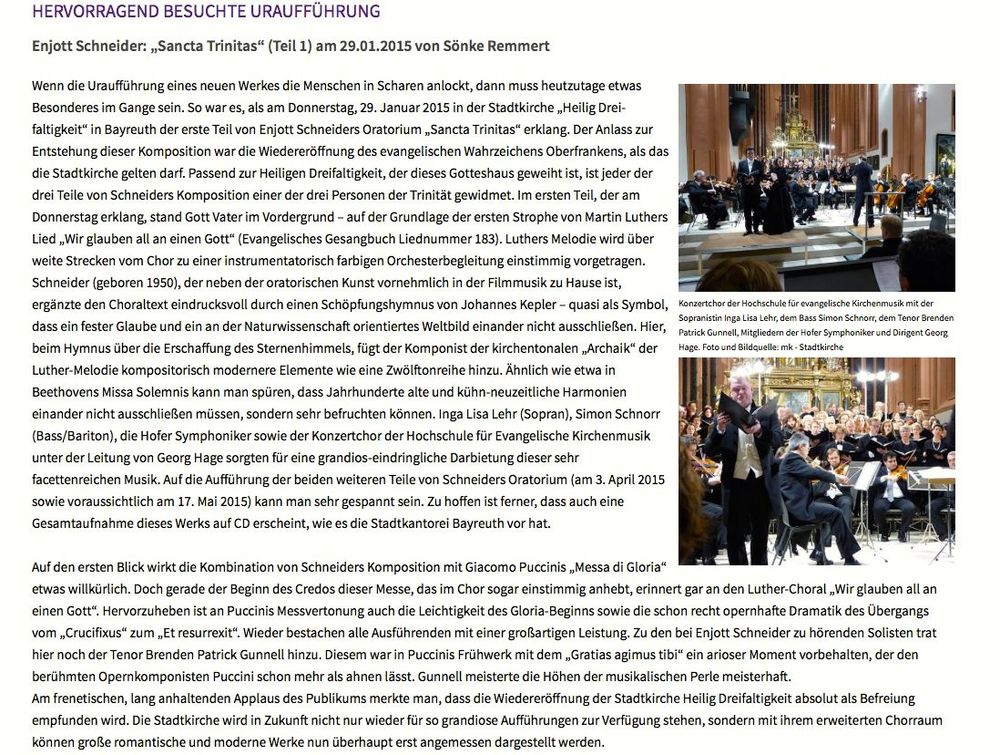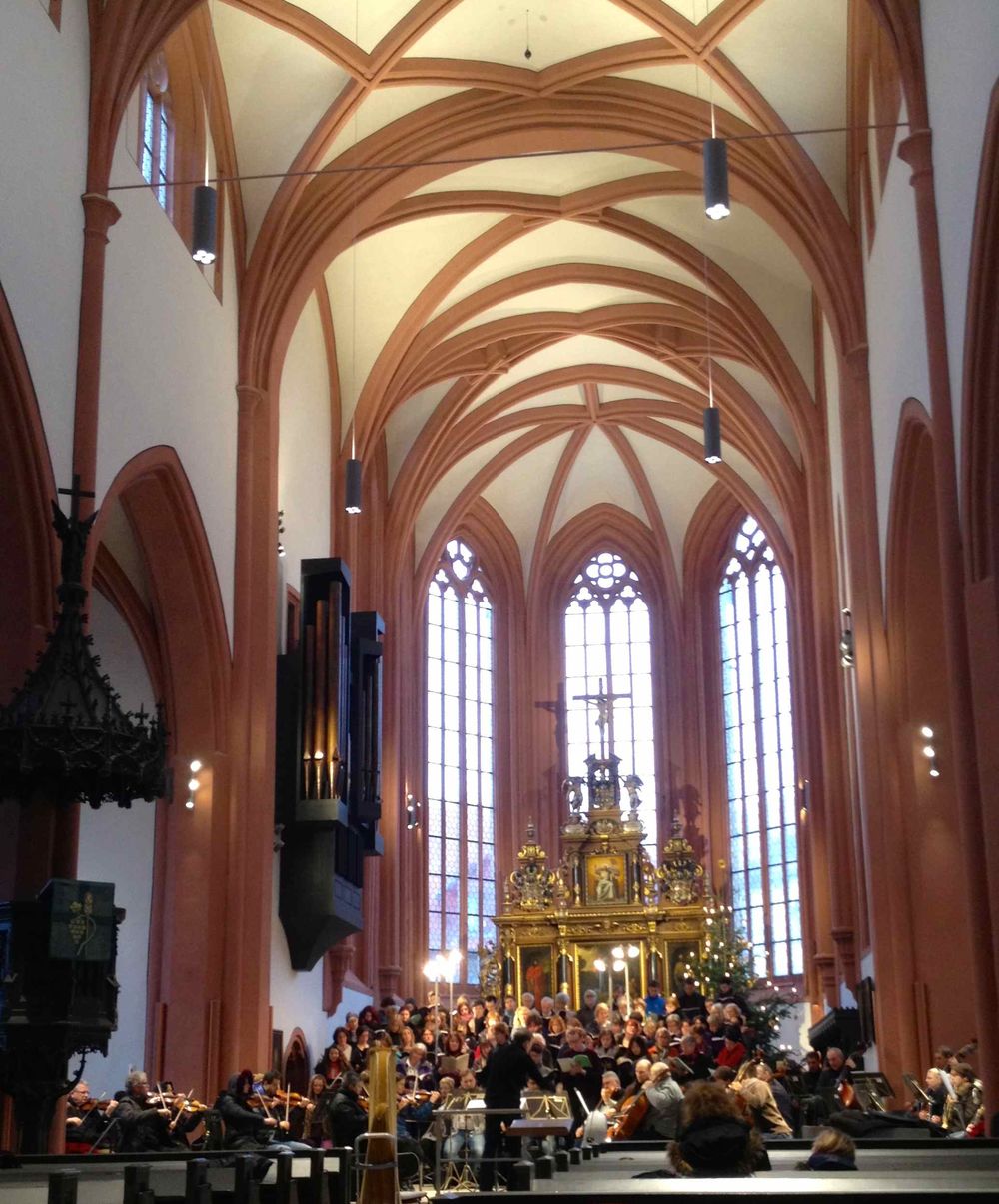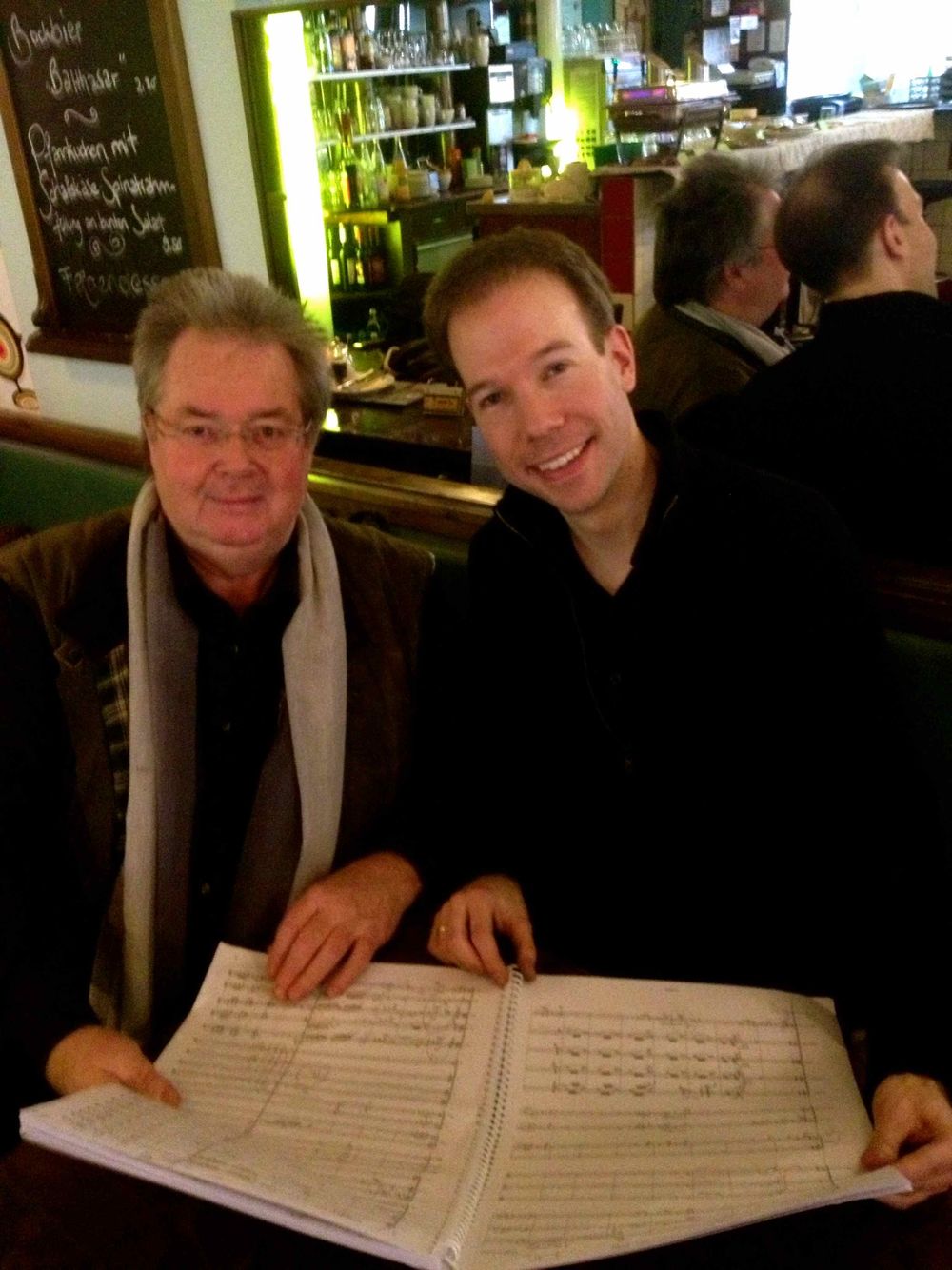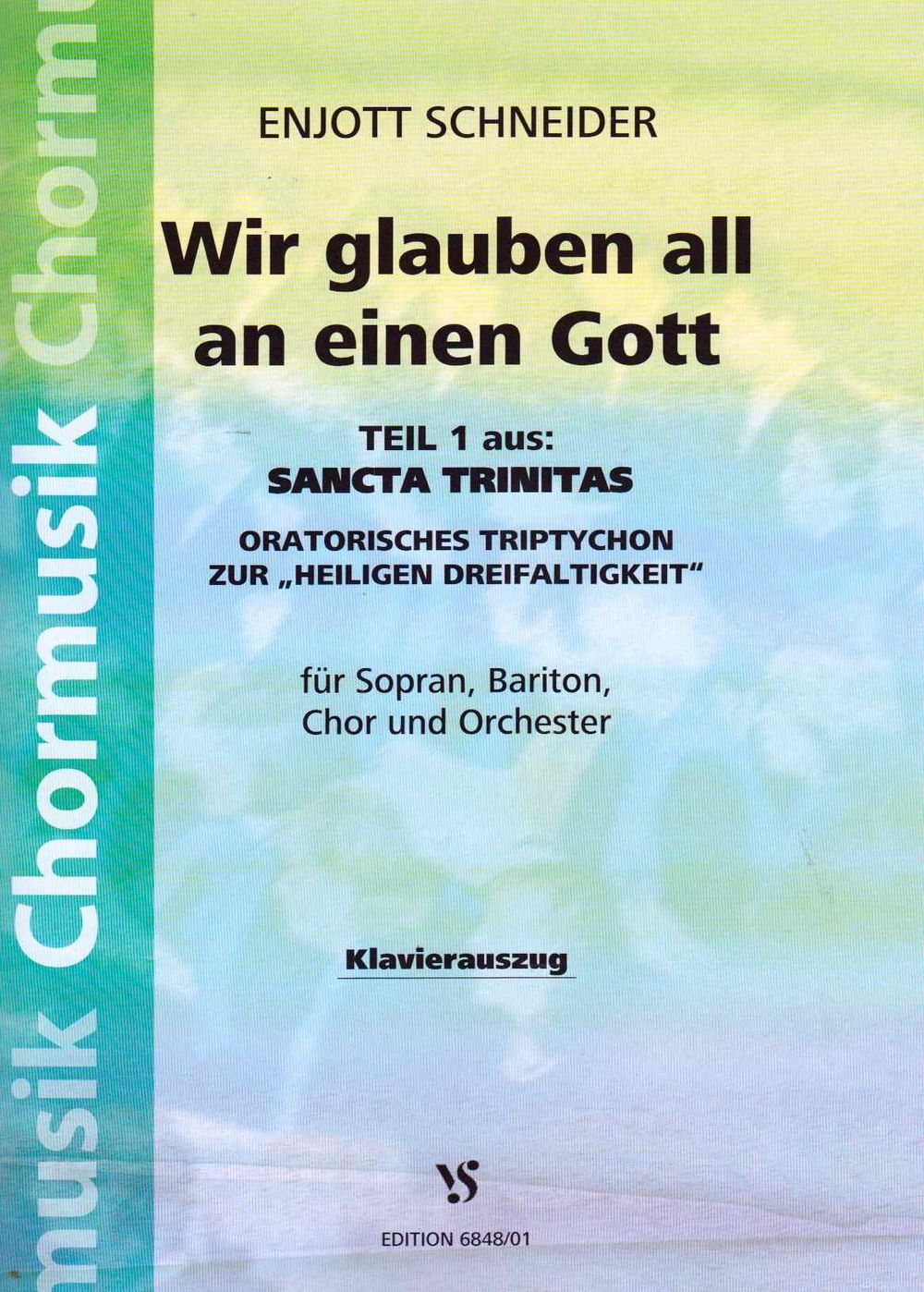
Category: Choir / Vocal , Organ / Sacred Music
Movements: SANCTA TRINITAS
ORATORISCHES TRIPTYCHON ZUR „HEILIGEN DREIFALTIGKEIT“
(oratorical triptych for the holy trinity)
for soprano, baritone, choir and orchestra
part 1: WIR GLAUBEN ALL AN EINEN GOTT (We all believe in one God)
1: Introduktion (Introduction) / 2: Jubilus “Wir glauben all“ (We all believe) / 3: „Er will uns allzeit ernähren“ (He wants to nurture us always) / 4: Exclamatio „Groß ist unser Herr“ (Great is our Lord) / 5: „Lobt ihn, Sonne, Mond und Planeten“ (Praise Him, sun, moon, and planets) / 6: „Von Ewigkeit zu Ewigkeit“ (From eternity to eternity)
Duration: 22 minutes
Publisher of notes/sheet music: Strube-Verlag Munich , 2014
Instrumentation: Soprano
Baritone
Choir (S A T B)
2 flutes
Oboe /English horn (1 player)
Clarinet / bass clarinet (1 player)
Bassoon
3 horns in F
3 trombones ( T T B)
Harp
1 drummer (large dr., small dr., tom-toms, tam-tam, triangle, 3 cymbals, vibraphone, wood block)
1 kettle drummer (medium-medium-low), also triangle
Strings (12-10-8-6-4)
Text/Lyrics by: Martin Luther / Johannes Kepler
Introduction: GENERAL PREFACE:
The overall subject and the texts were specified by the Evangelical City Church „Heilige Dreifaltigkeit“ (Holy Trinity) in Bayreuth, Germany and therefore suggested the conceptual design of a so-called „Oratorischens Triptychons“ (oratorical triptych) within the limits of a „Bayreuth Credo“, consisting of three individual oratorios with a duration of approx. 20 minutes each. The central and connecting element of it all is Martin Luther's 'Trinitätslied' (trinity song) 'WIR GLAUBEN ALL AN EINEN GOTT' (We all believe in one God) from the year 1524. With its three verses, the song clearly references the three articles of faith: Father, Son, and Holy Spirit. The melody in the very first church mode provokes the dematerialised tone of the archaic Gregorian musicology by oscillating with a melisma of five tones. Those five tones have a high recognition value when performed as a quintuplet and they accentuate the sense of 'togetherness' in an inimitable manner, as well the concept of congregation that become characteristic for the early Protestantism (in contrast to the hierarchically and patriarchally controlled pre-reformatory church).
Every part of the triptych contrasts the verse of Martin Luther's song with another free text (from the 'Kirchengesangsbuch' - church song book) as commentary. That is a doxology by Johannes Kepler (1571-1630) the the oratorio part 1 'WIR GLAUBEN ALL AN EINEN GOTT'. In the oratorio part 2 'JESUS CHRISTUS – MENSCH UND BRUDER', it is a petitionary text by Dietrich Bonhoeffer (1906-1945); this part can be considered the quiet center piece that focuses entirely on Jesus and the passion at the cross. The oratorio part 3 'SPIRITUS SANCTUS – TAUBE, WASSER, FEUERSTURM', retraces the Holy Spirit with the symbols of baptism and is full of floating and thunderous energy; the utilised commentarial text „Der Heilige Geist ist Quelle des Lebens“ by the mystic Hildegard von Bingen (1098-1179) subjectifies the bursting, blazing, burning and flaring with a very direct approach and leads to an impressive finale.
Oratorio Part 1: 'WIR GLAUBEN ALL AN EINEN GOTT'
The first oratorio consists of six movements, the first three of which are based on Luther's verse while the final three are based on Kepler's doxology:
1: Introduktion / 2: Jubilus “Wir glauben all“ / 3: „Er will uns allzeit ernähren“ /
4: Exclamatio „Groß ist unser Herr“ / 5: „Lobt ihn, Sonne, Mond und Planeten“ /
6: „Von Ewigkeit zu Ewigkeit“.
The first movements emphasise especially the first choral lines with the distinctive quintuplet in a mystical introduction; the joy of faith and the aesthetics of the surprise are revealed in a vital „Jubilus“, most prominently in the six-eight time; finally, the different moods are communicated to the listener in text and melody in additional choral lines. In order to stay true to the Martin Luther's choral, colourful harmonies and layered chords are used as the basis and only few free-tonal extensions are sought. Returning is a concise rhythmic motive „ta, tata, tatata“ that has become a temporal theme for the concept of the Holy Trinity as 1-2-3.
Contrary to that, the musical versions of Kepler's texts extend the tonality and the sound that is mostly based (although well hidden) on a 12-tone-series. My reason of this was the fascinating persona of Johannes Kepler. As theologian, astronomer, astrologer, optician, and natural philosopher, he focused on an endless world of stars and planets, with his telescope he provided evidence for the new Galilean world image, he discovered Kepler's laws: most importantly, though, he was faithful to the hermetic tradition of the Hermes Trismegistos, he studied the occult world and was a Pythagorean mystic. The orchestral part of the music attempts to capture some of this occult world, the spherical magic and the supernatural and mystical sound.
The texts of the 1st oratorio:
Martin Luther:
Wir glauben all an einen Gott, / Schöpfer Himmels und der Erden, / der sich zum Vater gegeben hat, / dass wir eine Kinder werden. /Er will uns allzeit ernähren, /Leib und Seel auch wohl bewahren; / allem Unfall will er wehren, / kein Leid soll uns widerfahren. / Er sorget für uns, hüt’ und wacht; / es steht alles in seiner Macht.
Johannes Kepler:
Groß ist unser Herr und groß seine Macht / und seiner Weisheit kein Ende! / Lobt ihn, Sonne, Mond und Planeten, / in welcher Sprache immer euer Loblied / dem Schöpfer erklingen mag! / Lobt ihn, ihr himmlischen Harmonien, / und auch ihr, die Zeugen und Bestätiger / seiner enthüllten Wahrheiten! / Und du meine Seele, / singe die Ehre des Herrn dein Leben lang! / Von ihm und durch ihn und zu ihm sind alle Dinge, / die sichtbaren und unsichtbaren. / Ihm allein sei Ehre und Ruhm / von Ewigkeit zu Ewigkeit. / Amen.
Additional remarks: Contract work for the Evangelical City Church „Heilig Dreifaltigkeit“ (Holy Trinity) in Bayreuth on the occasion of the 400th anniversary of the re-dedication and naming of the church
World premiere: 29.01.2015, Evangelical City Church „Heilig Dreifaltigkeit“ (Holy Trinity) in Bayreuth
Performers at world premiere: Concert choir of the 'Hochschule für Evangelische Kirchenmusik' Bayreuth, 'Hofer Symphoniker', Cond.: Georg Hage
